This is an old revision of this page, as edited by 117.197.76.133 (talk) at 13:53, 10 June 2015. The present address (URL) is a permanent link to this revision, which may differ significantly from the current revision.
Revision as of 13:53, 10 June 2015 by 117.197.76.133 (talk)(diff) ← Previous revision | Latest revision (diff) | Newer revision → (diff)
| Indo-Pakistani War of 1947–1948 | |||||||||
|---|---|---|---|---|---|---|---|---|---|
| Part of the Indo-Pakistani Wars | |||||||||
 Indian soldiers during the 1947–1948 war. | |||||||||
| |||||||||
| Belligerents | |||||||||
|
| |||||||||
| Commanders and leaders | |||||||||
|
|
| ||||||||
| Casualties and losses | |||||||||
|
1,500 killed 3,500 wounded |
6,000 killed ~14,000 wounded | ||||||||
| Conflict started when Pashtun tribal forces, and later Indian and Pakistani Army regulars, entered the princely state of Kashmir and Jammu. | |||||||||
| Indo-Pakistani conflicts | |
|---|---|
| Kashmir conflict
Other conflicts Border skirmishes Strikes |
The Indo-Pakistani War of 1947–1948, sometimes known as the First Kashmir War, was fought between India and Pakistan over the princely state of Kashmir and Jammu from 1947 to 1948. It was the first of four wars fought between the two newly independent nations. Pakistan precipitated the War a few weeks after independence by launching tribal lashkar (militia) from Waziristan, in an effort to secure Kashmir, the future of which hung in the balance. The inconclusive result of the war still affects the geopolitics of both countries.
On 22 October 1947, Muslim tribal militias crossed the border of the state, claiming that they were needed to suppress a rebellion in the southeast of the kingdom. These local tribal militias and irregular Pakistani forces moved to take Srinagar, but on reaching Uri they encountered resistance. Hari Singh made a plea to India for assistance, and help was offered, but it was subject to his signing an Instrument of Accession to India. British officers in the sub-continent also took part in stopping the Pakistani Army from advancing.
The war was initially fought by the J&K State Forces let by Major-General Scott and by tribal militias from the North-West Frontier Province (now Khyber Pakhtunkhwa) and the Federally Administered Tribal Areas. Facing the assault and a Muslim revolution in the Poonch and Mirpur area of Kashmir, the ruler of the princely state of Kashmir and Jammu, who was a Hindu, signed an Instrument of Accession to the Union of India. The Indian and Pakistani armies entered the war after this. The fronts solidified gradually along what came to be known as the Line of Control. A formal cease-fire was declared at 23:59 on the night of 1/2 January 1949.
Background
Prior to 1815, the area now known as "Jammu and Kashmir" comprised 22 small independent states (16 Hindu and 6 Muslim) carved out of territories controlled by the Amir (King) of Afghanistan, combined with those of local small rulers. These were collectively referred to as the "Punjab Hill States". These small states, ruled by Rajput kings, were variously independent, vassals of the Mughal Empire since the time of Emperor Akbar or sometimes controlled from Kangra state in the Himachal area. Following the decline of the Mughals, turbulence in Kangra and invasions of Gorkhas, the hill states fell successively under the control of the Sikhs under Ranjit Singh.
The First Anglo-Sikh War (1845–46) was fought between the Sikh Empire, which asserted sovereignty over Kashmir, and the East India Company. In the Treaty of Lahore of 1846, the Sikhs were made to surrender the valuable region (the Jullundur Doab) between the Beas River and the Sutlej River and required to pay an indemnity of 1.2 million rupees. Because they could not readily raise this sum, the East India Company allowed the Dogra ruler Gulab Singh to acquire Kashmir from the Sikh kingdom in exchange for making a payment of 750,000 rupees to the Company. Gulab Singh became the first Maharaja of the newly formed princely state of Jammu and Kashmir, founding a dynasty, that was to rule the state, the second-largest principality during the British Raj, until India gained its independence in 1947.
Partition of India
See also: Kashmir conflictThe partition of British India and the independence of the new dominions of India and Pakistan was the result of the Indian Independence Act 1947. Article 2 (4) of the Act provided for the termination of British suzerainty over the princely states with effect from 15 August 1947, and recognised the right of the states to choose whether to accede to India or to Pakistan or to remain outside them. Before and after the withdrawal of the British from India, the ruler of the princely state of Kashmir and Jammu came under pressure from both India and Pakistan to agree to accede to one of the newly independent countries. Faced with painful choices, the Maharaja of Kashmir, Hari Singh, decided to avoid accession to either country. Following a Muslim revolution in the Poonch and Mirpur area and an allegedly Pakistani backed Pashtun tribal intervention from the Khyber Pakhtunkhwa aimed at supporting the revolution, the Maharaja asked for Indian military assistance. India set a condition that Kashmir must accede to India for it to receive assistance. The Maharaja complied, and the Government of India recognised the accession of the princely state to India. Indian troops were sent to the state to defend it. The Jammu & Kashmir National Conference volunteers aided the Indian Army in its campaign to drive out the Pathan invaders.
Pakistan was of the view that the Maharaja of Kashmir had no right to call in the Indian Army, because it held that the Maharaja of Kashmir was not a hereditary ruler and was merely a British appointee, after the British defeated Ranjit Singh who ruled the area before the British conquest. There had been no such position as the "Maharaja of Kashmir" before that. Hence, Pakistan decided to take action, but the Army Chief of Pakistan General Sir Douglas Gracey, would not send troops to the Kashmir front, refusing to obey the order to do so given by Muhammad Ali Jinnah, Governor-General of Pakistan. Gracey justified his insubordination by arguing that Indian forces occupying Kashmir, like those of Pakistan, had taken an Oath of Allegiance to King George VI —in his roles of King of India and King of Pakistan— and hence he could not engage in a military conflict with Indian forces. Pakistan finally did manage to send troops to Kashmir, but by then the Indian forces had taken control of approximately two thirds of the former principality. The Gilgit and Baltistan territories were secured for Pakistan by the Gilgit Scouts and the Chitral Scouts of the state of Chitral, one of the princely states of Pakistan, which had acceded to Pakistan on 6 October 1947.
Stages of the war
The Rebellion in Poonch
In the Poonch region, there was a large number of ex-servicemen who had served in the British Indian Army and World War 2. Most of these ex-servicemen were of Sudhan origin and had a long-standing dissident relations with the Dogra regime. On April 21, 1947, Hari Singh was invited to Rawalakot, where a large number of ex-servicemen turned up and paraded with their weapons. This triggered a series of defensive maneavers by Hari Singh to disarm the locals and enforce stricter military control. The Poonch region had around 60,000 ex-servicemen were organising a 'Home Guard' that would attack the Dogra army at the right time. During the war, this group formed a War Council in Murree and most of the ammunition was smuggled from Darra Adam Khel and a large number of fighters from Waziristan and FATA were also injected through local contacts and the Pakistan Army.
Initial invasion
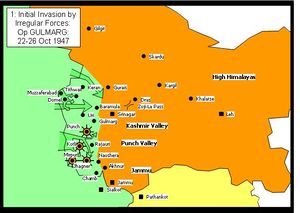
The first clash occurred at Thorar on October 3–4, 1947. On October 22 another attack was launched in the Muzaffarabad sector, The state forces stationed in the border regions around Muzaffarabad and Domel were quickly defeated by tribal forces (some Muslim state forces mutinied and joined them) and the way to the capital was open. Among the raiders, there were many active Pakistani Army soldiers disguised as tribals. They were also provided logistical help by the Pakistan Army. Rather than advancing toward Srinagar before state forces could regroup or be reinforced, the invading forces remained in the captured cities in the border region engaging in looting and other crimes against their inhabitants. In the Poonch valley, the state forces retreated into towns where they were besieged.

Indian operation in the Kashmir Valley
After the accession, India airlifted troops and equipment to Srinagar, where they reinforced the princely state forces, established a defence perimeter and defeated the tribal forces on the outskirts of the city. Initial defense operations included the notable defense of Badgam holding both the Capital and Airfield overnight against extreme odds. The successful defence included an outflanking manoeuvre by Indian armoured cars. during the Battle of Shalateng. The defeated tribal forces were pursued as far as Baramulla and Uri and these towns were recaptured.
In the Poonch valley, tribal forces continued to besiege state forces.
In Gilgit, the state paramilitary forces, called the Gilgit Scouts, joined the invading tribal forces, who thereby obtained control of this northern region of the state. The tribal forces were also joined by troops from Chitral, whose ruler, the Mehtar of Chitral, had acceded to Pakistan.

Attempted link-up at Poonch and fall of Mirpur
Indian forces ceased pursuit of tribal forces after recapturing Uri and Baramula, and sent a relief column southwards, in an attempt to relieve Poonch. Although the relief column eventually reached Poonch, the siege could not be lifted. A second relief column reached Kotli, and evacuated the garrisons of that town and others but were forced to abandon it being too weak to defend it. Meanwhile, Mirpur was captured by the tribal forces on 25 November 1947. Hindu women were reportedly abducted by tribal forces and taken into Pakistan. They were sold in the brothels of Rawalpindi. Around 400 women jumped into wells in Mirpur committing suicide to escape from being abducted.

Fall of Jhanger and attacks on Naoshera and Uri
The tribal forces attacked and captured Jhanger. They then attacked Naoshera unsuccessfully, and made a series of unsuccessful attacks on Uri. In the south a minor Indian attack secured Chamb. By this stage of the war the front line began to stabilise as more Indian troops became available.

Operation Vijay: counterattack to Jhanger
The Indian forces launched a counterattack in the south recapturing Jhanger and Rajauri. In the Kashmir Valley the tribal forces continued attacking the Uri garrison. In the north Skardu was brought under siege by the Gilgit scouts.
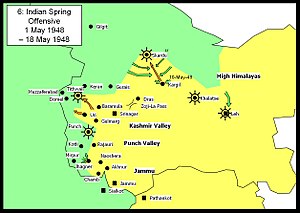
Indian Spring Offensive
The Indians held onto Jhanger against numerous counterattacks, who were increasingly supported by regular Pakistani Forces. In the Kashmir Valley the Indians attacked, recapturing Tithwail. The Gilgit scouts made good progress in the High Himalayas sector, infiltrating troops to bring Leh under siege, capturing Kargil and defeating a relief column heading for Skardu.
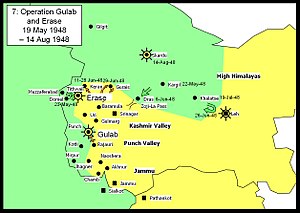
Operations Gulab and Eraze
The Indians continued to attack in the Kashmir Valley sector driving north to capture Keran and Gurais (Operation Eraze). They also repelled a counterattack aimed at Tithwal. In the Jammu region, the forces besieged in Poonch broke out and temporarily linked up with the outside world again. The Kashmir State army was able to defend Skardu from the Gilgit Scouts impeding their advance down the Indus valley towards Leh. In August the Chitral Forces under Mata-ul-Mulk besieged Skardu and with the help of artillery were able to take Skardu. This freed the Gilgit Scouts to push further into Ladakh.
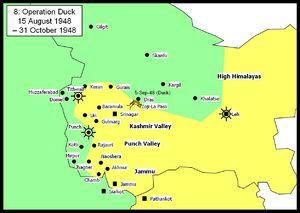
Operation Bison
Main article: Military operations in Ladakh (1948)During this time the front began to settle down. The siege of Poonch continued. An unsuccessful attack was launched by 77 Parachute Brigade (Brig Atal) to capture Zoji La pass. Operation Duck, the earlier epithet for this assault, was renamed as Operation Bison by Cariappa. M5 Stuart light tanks of 7 Cavalry were moved in dismantled conditions through Srinagar and winched across bridges while two field companies of the Madras Sappers converted the mule track across Zoji La into a jeep track. The surprise attack on 1 November by the brigade with armour supported by two regiments of 25 pounders and a regiment of 3.7-inch guns, forced the pass and pushed the tribal/Pakistani forces back to Matayan and later Dras. The brigade linked up on 24 November at Kargil with Indian troops advancing from Leh while their opponents eventually withdrew northwards toward Skardu.

Operation Easy; Poonch link-up
Main article: Military operations in Poonch (1948)The Indians now started to get the upper hand in all sectors. Poonch was finally relieved after a siege of over a year. The Gilgit forces in the High Himalayas, who had previously made good progress, were finally defeated. The Indians pursued as far as Kargil before being forced to halt due to supply problems. The Zoji La pass was forced by using tanks (which had not been thought possible at that altitude) and Dras was recaptured.
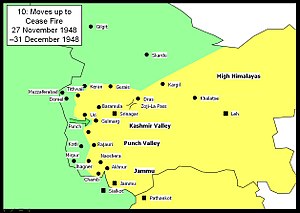
Moves up to cease-fire
After protracted negotiations a cease-fire was agreed to by both countries, which came into effect. The terms of the cease-fire as laid out in a United Nations resolution of 13 August 1948, were adopted by the UN on 5 January 1949. This required Pakistan to withdraw its forces, both regular and irregular, while allowing India to maintain minimum strength of its forces in the state to preserve law and order. On compliance of these conditions a plebiscite was to be held to determine the future of the territory. In all, 1,500 soldiers died on each side during the war and Pakistan was able to acquire roughly two-fifths of Kashmir, including five of the fourteen eight thousanders peaks of the world, while India maintained the remaining three fifths of Kashmir, including the most populous and fertile regions.
Military awards
Battle honours
After the war, a total of number of 11 battle honours and one theatre honour were awarded to units of the Indian Army, the notable amongst which are:
|
|
|
Gallantry awards
For bravery, a number of soldiers and officers were awarded the highest gallantry award of their respective countries. Following is a list of the recipients of the Indian award Param Vir Chakra, and the Pakistani award Nishan-E-Haider:
- India
- Major Som Nath Sharma (Posthumous)
- Lance Naik Karam Singh
- Second Lieutenant Rama Raghoba Rane
- Jadu Nath Singh
- Company Havildar Major Piru Singh Shekhawat
- Pakistan
See also
- Partition of India
- Kashmir Conflict
- Battle of Badgam
- Sino-Indian War
- Indo-Pakistani War of 1965
- Siachen war
- Kargil War
Notes
- Robert Blackwill, James Dobbins, Michael O'Hanlon, Clare Lockhart, Nathaniel Fick, Molly Kinder, Andrew Erdmann, John Dowdy, Samina Ahmed, Anja Manuel, Meghan O'Sullivan, Nancy Birdsall, Wren Elhai, Nicholas Burns (Editor), Jonathon Price (Editor). American Interests in South Asia: Building a Grand Strategy in Afghanistan, Pakistan, and India. Aspen Institute. pp. 155–. ISBN 978-1-61792-400-2. Retrieved 3 November 2011.
{{cite book}}:|author=has generic name (help)CS1 maint: multiple names: authors list (link) - Simon Ross Valentine (27 October 2008). Islam and the Ahmadiyya Jama'at: History, Belief, Practice. Hurst Publishers. p. 204. ISBN 978-1850659167.
{{cite book}}:|access-date=requires|url=(help) - ^ "Furqan Force". Persecution.org. Retrieved 14 March 2012.
- and the Ahmadiyya Jama'at: History, Belief, Practice. Columbia University Press, 2008. ISBN 0-231-70094-6, ISBN 978-0-231-70094-8
- "An incredible war: Indian Air Force in Kashmir war, 1947-48", by Bharat Kumar, Centre for Air Power Studies (New Delhi, India)
- By B. Chakravorty, "Stories of Heroism, Volume 1", p. 5
- ^ By Sanjay Badri-Maharaj "The Armageddon Factor: Nuclear Weapons in the India-Pakistan Context", p. 18
- Pakistan Covert Operations
- "Who changed the face of '47 war?". Times of India. 14 August 2005. Retrieved 14 August 2005.
- ^ Marin, Steve (2011). Alexander Mikaberidze (ed.). Conflict and Conquest in the Islamic World: A Historical Encyclopedia, Volume 1. ABC-CLIO. p. 394. ISBN 978-1598843361.
- Victoria Schofield(2003), Kashmir in Conflict: India, Pakistan and the Unending War
- ^ Kashmir in Encyclopædia Britannica (2011), online edition
- ^ Lamb, Alastair (1997), Incomplete partition: the genesis of the Kashmir dispute 1947–1948, Roxford, ISBN=0-907129-08-0
- ^ Prasad, S.N.; Dharm Pal (1987). History of Operations in Jammu and Kashmir 1947–1948. New Delhi: History Department, Ministry of Defence, Government of India. (printed at Thomson Press (India) Limited). p. 418.
- Hutchison, J.; Vogel, Jean Philippe (1933). History of the Panjab Hill States. Superint., Gov. Print., Punjab. Retrieved 23 October 2011.
- ^ Srinagar www.collectbritain.co.uk.
- Indian Independence Act 1947 (c.30) (Revised Statute) from The UK Statute Law Database at opsi.gov.uk
- Kashmir-konflikten. (18 October 2011) I Store norske leksikon. Taken from http://snl.no/Kashmir-konflikten
- Norwegian Broadcasting Corporation: Kashmir-konflikten
- My Life and Times. Allied Publishers Limited. Retrieved 1 July 2010.
- Martin Axmann, Back to the future: the Khanate of Kalat and the genesis of Baluch Nationalism 1915-1955 (2008), p. 273
- ^ Regimental History Cell, History of the Azad Kashmir Regiment, Volume 1 (1947-1949), Azad Kashmir Regimental Centre, NLC Printers, Rawalpindi,1997
- I Indo-Pakistani War, 1947–1949 By Tom Cooper Air Combat Information Group 29 October 2003
- Ministry of Defence, Government of India. Operations in Jammu and Kashmir 1947–1948. (1987). Thomson Press (India) Limited, New Delhi. This is the Indian Official History.
- http://www.indiandefencereview.com/interviews/defence-of-srinagar-1947/
- Tikoo, Colonel Tej K. (2013). "Genesis of Kashmir Problem and how it got Complicated: Events between 1931 and 1947 AD". Kashmir: Its Aborigines and their Exodus. New Delhi, Atlanta: Lancer Publishers. ISBN 1935501585.
- This All Began in 1947: The Jihadist Operations of Pakistani State. Criticalppp.com (2012-08-14). Retrieved on 2013-07-12.
- Sinha, Lt. Gen. S.K. (1977). Operation Rescue:Military Operations in Jammu & Kashmir 1947–49. New Delhi: Vision Books. p. 174. ISBN 81-7094-012-5. Retrieved 4 August 2010.
- Resolution adopted by the United Nations Commission for India and Pakistan on 13 August 1948
- Global security
- Singh, Sarbans (1993). Battle Honours of the Indian Army 1757 – 1971. New Delhi: Vision Books. pp. 227–238. ISBN 81-7094-115-6. Retrieved 3 November 2011.
Bibliography
- Major sources
- Ministry of Defence, Government of India. Operations in Jammu and Kashmir 1947–1948. (1987). Thomson Press (India) Limited, New Delhi. This is the Indian Official History.
- Lamb, Alastair. Kashmir: A Disputed Legacy, 1846–1990. (1991). Roxford Books. ISBN 0-907129-06-4.
- Praval, K.C. The Indian Army After Independence. (1993). Lancer International, ISBN 1-897829-45-0
- Sen, Maj Gen L.P. Slender Was The Thread: The Kashmir confrontation 1947–1948. (1969). Orient Longmans Ltd, New Delhi.
- Vas, Lt Gen. E. A. Without Baggage: A personal account of the Jammu and Kashmir Operations 1947–1949. (1987). Natraj Publishers Dehradun. ISBN 81-85019-09-6.
- Other sources
- Cohen, Lt Col Maurice. Thunder over Kashmir. (1955). Orient Longman Ltd. Hyderabad
- Hinds, Brig Gen SR. Battle of Zoji La. (1962). Military Digest, New Delhi.
- Sandhu, Maj Gen Gurcharan. The Indian Armour: History Of The Indian Armoured Corps 1941–1971. (1987). Vision Books Private Limited, New Delhi, ISBN 81-7094-004-4.
- Singh, Maj K Brahma. History of Jammu and Kashmir Rifles (1820–1956). (1990). Lancer International New Delhi, ISBN 81-7062-091-0.
- Ayub, Muhammad (2005). An army, Its Role and Rule: A History of the Pakistan Army from Independence to Kargil, 1947–1999. RoseDog Books. ISBN 9780805995947.
| Kashmir conflict | |
|---|---|
| Wars and conflicts | |
| Border skirmishes | |
| Operations | |
| Negotiations | |
| Bombings and massacres |
|
| Militant organisations | |
| Observances |
|
| Related | |
| Military history of Pakistan | |||||
| Leadership |
| ||||
| Services |
| ||||
| Paramilitary | |||||
| Personnel |
| ||||
| Business interests |
| ||||
| Criticism | |||||
- Use dmy dates from March 2013
- Indo-Pakistani wars
- Kashmir
- Conflicts in 1947
- Indo-Pakistani War of 1947
- Wars involving India
- Conflicts in 1948
- History of Azad Kashmir
- History of Jammu and Kashmir
- Military history of Pakistan
- Kashmir conflict
- 1947 in India
- 1948 in India
- Government of Liaquat Ali Khan
- Nehru administration